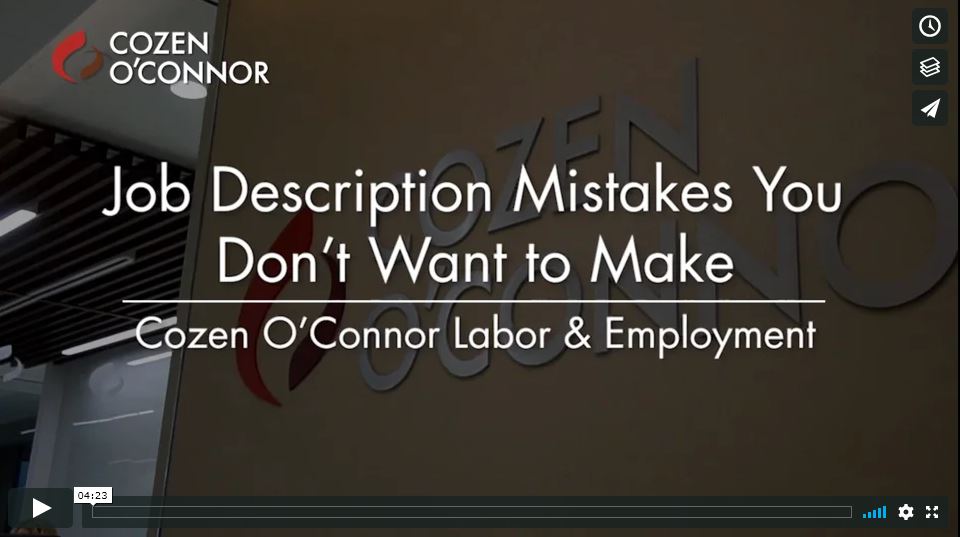A good job description can equip an employer with the best possible workforce available. Inaccuracies and oversights, however, can entangle your company in litigation for years. Bethany Salvatore and Bryant Andrews talk us through the importance of job descriptions here.
Video Transcript:
Bethany: Hi, my name is Bethany Salvatore. I, along with my colleague, Bryan Andrews, are labor and employment attorneys at Cozen O’Connor. As labor and employment attorneys, our clients often ask us questions relating to wage and hour issues, discrimination issues, FMLA leave issues, termination issues. Quite frankly, the wide range of employment-related issues. Today, we just wanted to take a few moments to talk with you about one discreet aspect of an employer’s obligations to their employees, and that is job descriptions.
Bryant: That’s right. A good job description can equip an employer with the best possible workforce available. Inaccuracies and oversights, however, can entangle your company in litigation for years. Bethany, in your experience what are some elements that are required for a good job description?
Bethany: A good job description must list the essential and non-essential function of an individual’s job. If an employer does not list essential functions of an employee’s job, it can be placed in a very awkward position later when attempting to assert that employee is either not performing adequately or, in some circumstances, is not able to be accommodated under the Americans with Disabilities Act, for example.
Bryant: What are some practical ways that you’ve seen this play out in litigation?
Bethany: I can tell you, just from a recent case in 2018, the Miller versus Coca Cola case, that was a failure to accommodate case under the Americans with Disabilities Act. In that case, the employer put forward a very solid job description and that job description listed essential functions of that individual’s job. One of the essential functions of that individual’s job was the ability to lift 50 pounds. At issue in that case was whether or not the employer was able to reasonably accommodate the individual, such that the individual would, with reasonable accommodation, be able to meet that lifting requirement. Ultimately, that employee was not able to meet that lifting requirement and was let go. The employer filed for summary judgment in that case and ultimately prevailed, in part because the job description very clearly defined one component of that individual’s essential functions, which happened to be the issue in the case.
Bryant: Wow. Yeah, I can think of another example where job descriptions interact with federal law. Under the Fair Labor Standards Act, or the FLSA, an employer has an obligation to pay overtime to non-exempt employees who work in excess of 40 hours in any given week. This exempt or non-exempt status is determined in part by the employee’s job duties and so courts will take into account the job description, of course, in determining job duties and will look to the essential functions of the employee’s job. So it’s critical that employers have a detailed and accurate and exhaustive list of those essential functions of the employee’s job duties to help assist courts in their determination. We see that when employers do this well, it can really help them prevail in litigation.
Bethany: That’s right.
Bryant: As we launch here into 2019, we just encourage you to take a look at your employee’s job description. Review them, see if they need any updates. We believe this will help you not only to continue to recruit and secure the best possible workforce, but it will also help to minimize any potential litigation that might come up. If you’re in the middle of litigation now, we believe it might help you to prevail by having a strong, exhaustive, accurate list of the employee’s essential job duty.
Bryant: If you have any questions after watching our first vlog here and you’d like to reach out to us, our contact information is in the vlog description. Again, my name is Bryant Andrews, this is my colleague, Bethany Salvatore. We’re with Cozen O’Connor. Feel free to reach out to us with any questions and we’ll see you next time.
Bethany: Thank you.



Leave a Reply